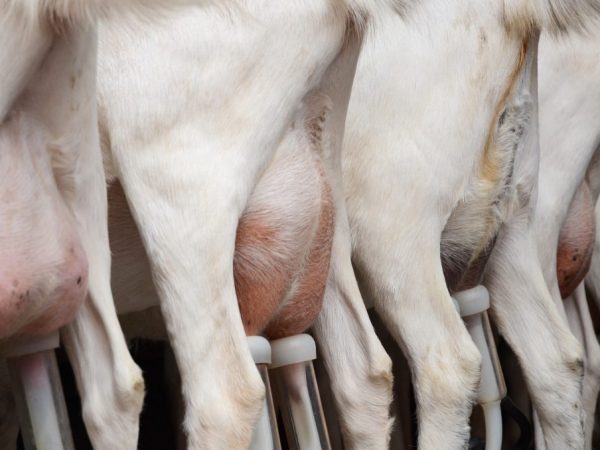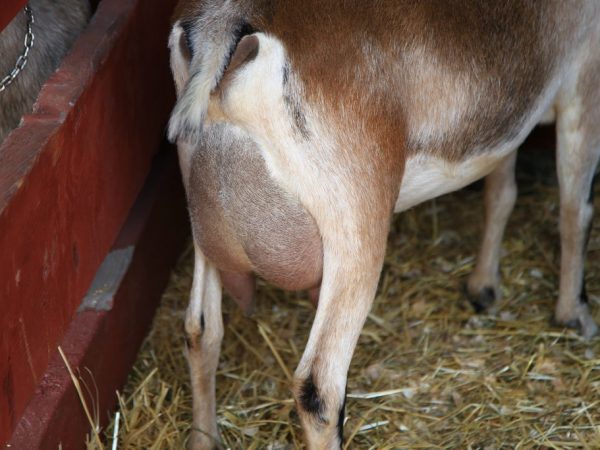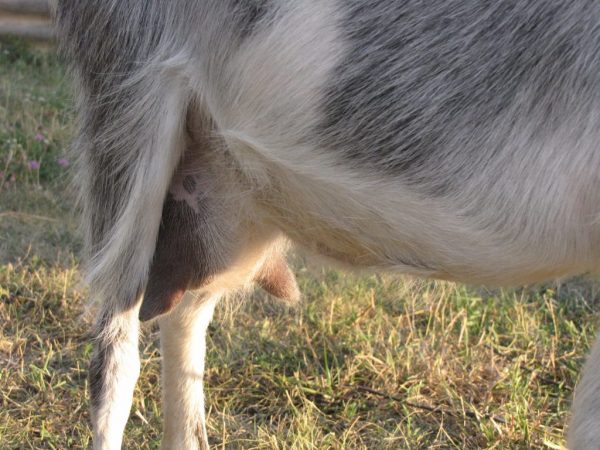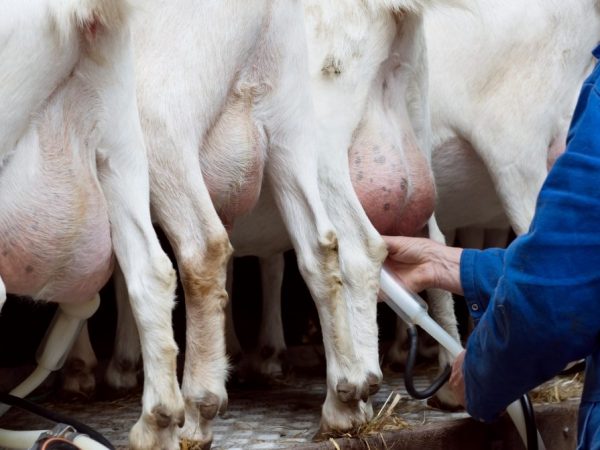How to treat goat mastitis
Breeding goats is a lucrative business that can be a hassle, however. It doesn't matter how you farm, how big your farm is, or what goals you pursue by raising goats. Despite the fact that it is impossible to call a whimsical and demanding goat in care, nevertheless, you will have to work hard and get nervous if the horned one suddenly gets sick. One of the most common diseases among goats is goat mastitis, because this animal is dairy and has an udder. The fact is that it is quite difficult to treat mastitis in a goat, especially if you plan to do it yourself at home. Today we will learn about what signs of mastitis and what should be the treatment for mastitis in a goat, how long the course of treatment for mastitis in a goat lasts, what drugs are used for this, how positive the prognosis will be.

Goat mastitis
How to tell if a goat has mastitis
How do you know if a goat has mastitis? First you need to figure out what constitutes mastitis in a goat, what symptoms occur with this disease. Cattle mastitis is an inflammatory disease that can occur in two stages - acute or chronic. The affected area is the udder, that is, in the mammary gland of the animal.
Let's figure out what signs of mastitis are in goats. The following symptoms of mastitis in goats can signal that a goat is sick:
- Blood may appear in milk
- Outwardly, the disease can manifest itself as a noticeable increase in one of the lobes of the udder
- On palpation, you can feel that the organ has become hard and not plastic, that is, seals appear, which can increase as the condition of the animal aggravates
- The volume of milk obtained after milking has dropped sharply
- The quality of the resulting product also changes, there may be clots with mucus in the fresh milk, the color may become more transparent or, on the contrary, cloudy
- During a standard examination, you can find that the body temperature of the goat is elevated, and touching the udder is painful, the animal looks tired
It is important to carry out preventive examinations periodically, so you will have more opportunity to notice the very beginning of the disease, it is at this stage that mastitis is easiest to cure. It is worth remembering that mastitis in a goat does not appear immediately, it may take about a week for the first signs to appear.
It also happens that the symptoms of mastitis are blurred and not pronounced, then we should talk about the latent form of the disease, namely the subclinical form, it is also called latent mastitis. In this case, in order to understand whether the goat is sick with mastitis, you need to carry out a simple manipulation with freshly milked milk. Pour it into a transparent container, let the product turn sour and carefully examine what has precipitated.If clots of mucus and pus, or even blood, remain at the bottom, the goat is most likely sick with mastitis and needs treatment.
Why does mastitis appear?
No disease occurs for no reason, the same goes for mastitis in goats. The disease occurs due to the clogging of the ducts through which milk comes out, leaving the udder. Typically, a blockage occurs because the milkmaid does not properly milk the animal during milking. Also, mastitis is often found in those animals that have recently lambed, since their immunity and defense system at this time are not in the best condition. The reason in this case is an infection that has got from the environment into the dairy organ of the animal. If the infectious nature of mastitis is confirmed, treatment will necessarily include antibiotics, which are mandatory prescribed by a doctor.
It is also worth listing other reasons that provoke the development of mastitis not only in goats, but also in other representatives of cattle:
- Technique and hygiene rules are not followed during milking
- Mastitis can be a complication of an existing infection in a goat
- The goat does not receive a balanced caloric diet, from which its immunity is lowered
- Trauma or pathology in the structure of the udder
How to treat mastitis at home

The goat is separate from the others
What if your goat has mastitis? The first thing the owner should do after confirming the diagnosis is to protect the sick goat from contact with healthy animals. This is necessary in order to prevent the spread of the disease and infect healthy cattle.
In addition, it is imperative to carry out a general cleaning in the room where the goats are kept. At the same time, the entire litter changes, and the walls are whitewashed, this will help to overcome the infection as soon as possible. A sick animal currently needs to be given maximum attention, it should be peace and quiet, only the highest quality feed and constant access to clean water.
It does not matter where the goat will be treated, and who will do it, the whole course can be divided into three stages:
- Pain relief, in other words, pain relief - home treatment begins with it
- Fighting infection, i.e. antibiotic therapy
- Reducing inflammation, that is, all measures aimed at making the udder smaller and freeing the milk ducts
Udder pain relief
The first thing to worry about is to relieve the animal of the torment, namely the pain that it experiences during mastitis. To do this, you can use an ointment with novocaine, you can buy it at a regular pharmacy without a prescription. The affected nipples and the diseased share of the udder are treated with an external agent. After the ointment begins to act, you can proceed to a therapeutic massage, which will facilitate the speedy evacuation of stagnation in the milk ducts.
If the massage does not turn out to be effective, you can introduce a soda solution into the udder, while the percentage of soda content should not be higher than two percent, and a single administered dose should be 10-15 ml. After the injection is made, you need to shake the diseased part of the udder well so that the soda solution gets into all the ducts. Thus, the permeability of milk and serous fluid can be significantly improved.
If this does not help, you can turn to at least, namely, intramuscular administration of oxytocin. However, it is worth remembering that you can use it no more than once a day, otherwise it can entail a lot of side effects. It should be said that all milk during mastitis in a goat, milked during treatment and medical manipulations, should not be drunk in any case, it must be immediately disposed of. Udder massage should be performed at least two to three times a day.
If novocaine ointment turned out to be useless and did not have the proper analgesic effect, you can apply the scheme used by veterinarians.To do this, you will need novocaine, but already in liquid form, namely in the form of ampoules for intravenous or intramuscular administration. It is necessary to dilute a 0.25% ampoule of novocaine with saline and inject the goat into the thigh once a day, preferably in the evening. The dose is calculated on the basis of the rule - 0.5 milliliter per 1 kg of animal weight.
Speaking of novocaine, it must be said that its use is strictly contraindicated together with antibiotics of the sulfonamide group, otherwise the anesthetic will negate the effect of therapeutic therapy.
Treating mastitis with antibiotics

You can't do without medicines
Naturally, in the presence of bacteria and microbes in the analysis of the goat, it is worth using antibiotics, otherwise it simply cannot be. However, it should be understood that only an analysis, namely bacterial inoculation, can answer the question of what kind of antibiotic can in a particular case. If you have neither the opportunity nor the time to do such a study, then it makes sense to treat the animal with several groups of antimicrobial agents at once. For example, it can be three drugs at once - streptomycin, penicillin and tetracycline. Such a scheme is especially relevant when it comes to catarrhal or serous mastitis.
Veterinarians respond positively to the treatment regimen based on streptomycin in tandem with bicillin. Before administration, both powders must be thoroughly mixed and dissolved in sterile water. Then you need to disinfect the future injection site by wiping it with a swab in alcohol. The drug must be drawn with a syringe, for this a small syringe with a volume of 5 ml is suitable. The drug is administered slowly, so that the entire dose is inside the animal. The course of treatment lasts at least 5 days, unless another is prescribed by the veterinarian, and the intervals between injections are about 12-18 hours.
Application of Mastiet Forte for mastitis in goats
Mastiet forte has proven itself quite well for the treatment of mastitis. The drug can be purchased only in liquid form, namely in the form of a suspension. The advantage of the medicine is that it contains an antibiotic and a hormonal anti-inflammatory agent. It can even cure catarrhal, serous mastitis in goats and hemorrhagic form of mastitis in goats.
We will learn how to properly inject the drug Mastiet forte:
- The first thing to do according to the instructions for using the drug is to empty the diseased share of the udder from milk
- Take disinfectant measures for the affected nipple
- Place the sterile disposable tip into the udder milk channel
- Inject the medication into the duct
- Gently pull out the syringe and pinch the nipple with your fingers to prevent the medicine from flowing back
Such treatment is carried out no more than once a day; it is better to choose night time for this. The minimum interval between injections of Mastiet Forte is at least twelve hours. Some farmers advise making a warming compress for the udder after the injection.
Do not forget that all the manipulations that you carry out to treat mastitis in a goat must be carried out in protective clothing to prevent infection of other individuals.
It is also important to say that there are a lot of remedies that can help the main treatment, they are also called folk remedies. One of the successful examples is ichthyol ointment, it can be applied in between injections of Mastiet forte.
How to treat false mastitis

Determine if there is mastitis
Now you know how to identify mastitis in a goat at home. It's time to figure out what false mastitis is. This is a situation when the following symptomatic picture is observed in a goat:
- Nipples get rough
- Udder swelling appears
- Milk drainage is difficult
- There are no foreign inclusions in milk
In this case, they do not talk about mastitis, most likely, the goat has a breast or, as it is also called, a typical swelling of the udder.In this case, you do not need to treat the goat with antibiotics, the condition of the animal can be improved by using diuretics and regularly expressing milk. It is worth noting that massages in this case are strictly prohibited, they can aggravate the condition of the animal and provoke the development of true mastitis.
Let's talk about an old folk way of how to deal with false mastitis in cattle. To do this, you need a regular dill broth. To prepare it, you will need about 20 tablespoons. dill seeds and 30 liters of hot water. After the dill with water has been infused for about 2 hours, start giving it to the goat. The animal should drink about 15 liters of this drink per day. If the goat refuses it, it is allowed to add a little sugar to it.
Features of the chronic stage of mastitis in a goat
The chronic form of mastitis is a consequence of an untreated acute form. Unfortunately, it is unlikely that it will be possible to completely rid the animal of the disease, but the quality of its life can be significantly improved. It is important to note that it is recommended to stabilize the goat's condition before she becomes pregnant so that there are no problems with feeding the kids in the future.
At home, you can treat the udder with a regular cream for children, it will soften the rough skin. Also, use the previously described method of soldering the animal with dill water, this will reduce swelling. In addition to dill, infusions can also be prepared on herbs such as erva, as well as on lingonberries, all this will help the goat.
Provide the goat with maximum comfort, the animal should not experience stress and excitement, the room should be dry, light and warm, it is important to protect the sick animal from drafts.
Prevention of mastitis in goats
As mentioned earlier, mastitis is easier to treat early on. To do this, it is worth paying enough attention to preventive examinations for mastitis. In addition, prevention will ensure that painful symptoms do not return to an already recovered animal.
Also, do not forget that the goat should live in comfortable conditions, the room with cattle should be clean, milking should be done only by a specially trained person who knows the technique well, do not forget that at the beginning and after milking, you need treat nipples with disinfectants to prevent infection. Often, non-observance of the elementary rules of keeping and caring for livestock is the reason that mastitis comes back again and again even after treatment.
Now you know what are the signs of mastitis in a goat, how to treat mastitis in a goat, what drugs are used for mastitis in a goat, and what preventive measures should be taken. In conclusion, let's say that the treatment of mastitis in goats, ideally, should be supervised by a veterinarian, since self-medication can be fraught and have a lot of side effects.


